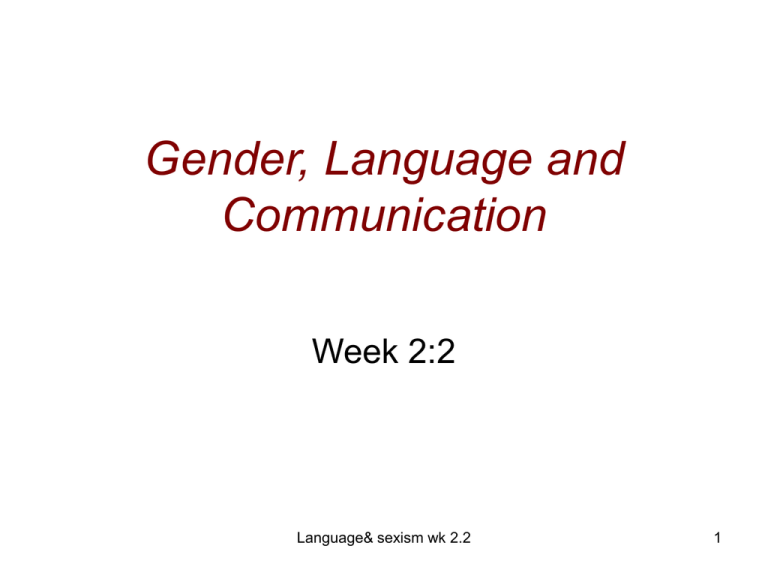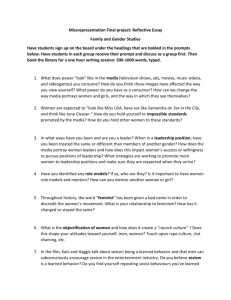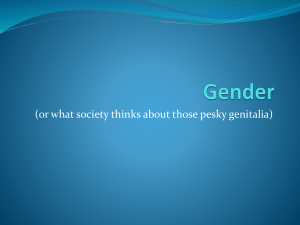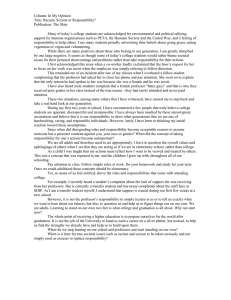Gender, Language and Communication Week 2:2 Language& sexism wk 2.2
advertisement

Gender, Language and Communication Week 2:2 Language& sexism wk 2.2 1 Sexism & Language A. Connotations governor – governess master – mistress patron – matron sir – madam bachelor – spinster Word Pairs brothers & sisters husband & wife boys & girls hostess & host queen & king Eve & Adam Language& sexism wk 2.2 2 Sexism & Language Generic He/Man • policeman • spokeman • manpower • Social Man • mankind • workman’s compensation • “Man the oars” • he, him, his Language& sexism wk 2.2 3 • Part A. Connotations • Words associated with men appear on the left, those with women on the right. What does each word connote to you? • Power, authority, positively valued while for women….. • What did spinster mean originally? Semantic Derogation over time? Word becomes associated with women often acquires semantic characteristics congruent with social stereotypes and evaluations – women as a group (PM Smith in Renzetti & Curran). • • • • • What do these connotations say abt the status of women in society? Generally men associated with positive things, women negative things? “Shrew” from the name of a small, but vicious, animal is defined in most dictionaries as “an ill-tempered scolding woman.” A shrewd businessman has different connotation, “clever, discerning awareness” . Patron of the arts vs a matron who supervises a public institution or simply an old woman. Would you rather be an old master (someone who has achieved consummate ability in your field) or an old mistress Language& sexism wk 2.2 4 Word Pairs • Read each word pair. What if you reverse them? Sound incorrect, awkward? • Traditionally placing the female term after the male term signifies something? Status of women? “ the supreme Being…is in languages Masculine, in as much as the masculine Sex is the superior and more excellent” (quoted in Baron, 1986) • Linguistic Sexism is the larger problem of semantic derogation • Linguistic sexism – ways in which a language devalues members of one sex (women), defining women’s “place” in society unequally & ignoring women. Example: titles of respect for men, Mr which reveals nothing about relationship to women. While women being addressed as Miss or Mrs – define women in terms of their relationships to men. Husband & wife having Ph.Ds-commonly adddressed as Dr & Mrs. How is a woman’s identity subsumed? Language& sexism wk 2.2 5 Generic He/Man • What image comes to your mind when reading the words? • Do you visualize women, women and men together, or men alone? Only men • “he/man” language frequently results in “cognitive confusion” or misunderstanding • How can sexist language be changed? Individuals (you & me), organizations • Ms for Miss & Mrs, Alternating the order of feminine & masculine nouns and pronouns • She/he, or he and she or they for he/man • Police officer, spokesperson, businessperson Language& sexism wk 2.2 6 Do Women & Men Speak Different Language • Deborah Tannem (1990,1994 a&b) argues women & men are of different speech communities • Different communication styles and goals. • Women & men speak different genderlects just as people from cultures speak different dialects. • Women speak & hear a language of intimacy & connection. Men uses language of status & independence. • Therefore, when women & men converse, the conversations often become product of two different cultures resulting in misunderstanding. • Some studies using large sample found few communication differences among gender, but both women & men communication patterns and styles are influenced by situational factors: sex the receiver, the context, the perceived status of both speaker and receiver. Language& sexism wk 2.2 7 On listening reactions, few differences between female and male listeners except female gave more “active understanding” responses (explicit acknowledgment of the speaker’s feelings) when the speaker was a female friend. Is communication an interactive process affected by a variety of factors of which gender is only one? Many researchers observed gender inequality characterizes much daily communication, reflecting differences in men’s and women’s life experiences, social status, power (Henley et al., 1985) -In cross-sex conversations, men are found to do more of the talking which in many situations give them more opportunity to express their opinions (business meetings). Plus men have more success than women in getting the conversation focused on topics. Listeners of both sexes more actively attend to men when they speak than to women speakers (McConnell-Ginet, 1989). Non verbal communication of men in cross-sex interaction – dominant. They control more space than women, they invade women’s personal space more than women invade men’s by standing closer to them, and by touching and staring at them more. Language& sexism wk 2.2 8 • Women tend to avert their eyes when stared at by men, but they also smile and laugh more than men whether they are happy or not, a gesture viewed as both social and submissive. • Research on same-sex conversation showed that in all female groups, women talk more than men do in all male groups. • Men prefer to talk more about sports, work; women prefer to indulge more about personal topics (Bischoping, 1993). • Women conversations are less individualistic and more dynamic than men’s conversation in same-sex interaction. Women enlarge on and acknowledge one another’s contributions, respond to conversationalist’s attempts to introduce topics.. • Although interruptions are frequent in women’s conversations, these are typically supportive rather than aggressive Language& sexism wk 2.2 9 • Women’s conversations are being stereotyped as gossiping • Although interruptions are frequent in women’s conversations, these are typically supportive rather than aggressive • Women’s conversations are being stereotyped as gossiping whereas men’s conversations with another are regarded as more serious and important. • Wld these negative traits and consequences of communication differences associated exclusively with women have to do with men having greater power to define acceptable standards of communication? Obviously, women’s communications are considered not only different from men’s, but also typically inferior (Lakoff, 1990) Language& sexism wk 2.2 10 Is the Situation Changing ? • Some evidence the situation may be changing. • Berryman-Fink (1994)-no difference in how women & men (sups, peers, or subordinates) rated the communication competency of women in the work place. In self-evaluations, women rated their communication competency lower than others rated men. Women need to develop greater self confidence in certain communication settings. Language& sexism wk 2.2 11





